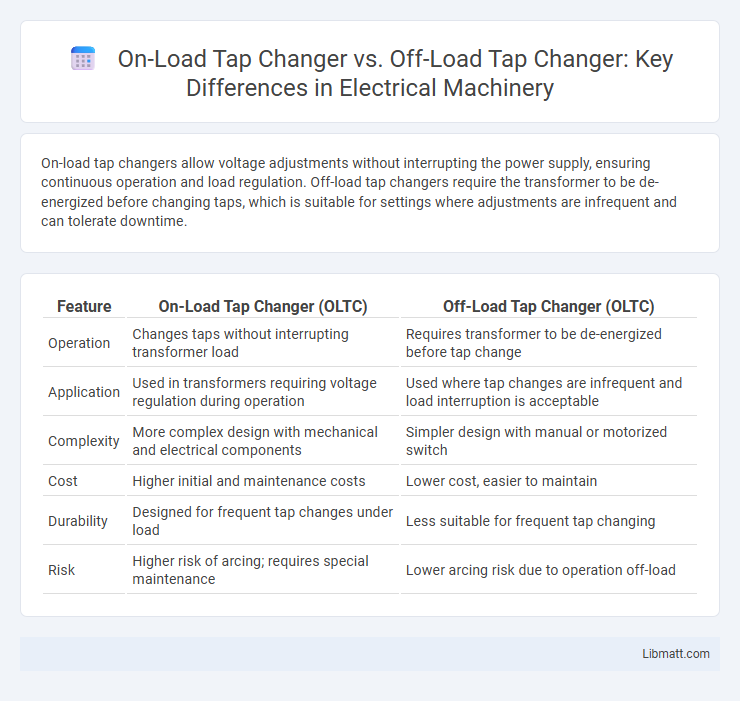On-load tap changers allow voltage adjustments without interrupting the power supply, ensuring continuous operation and load regulation. Off-load tap changers require the transformer to be de-energized before changing taps, which is suitable for settings where adjustments are infrequent and can tolerate downtime.
Table of Comparison
| Feature | On-Load Tap Changer (OLTC) | Off-Load Tap Changer (OLTC) |
|---|---|---|
| Operation | Changes taps without interrupting transformer load | Requires transformer to be de-energized before tap change |
| Application | Used in transformers requiring voltage regulation during operation | Used where tap changes are infrequent and load interruption is acceptable |
| Complexity | More complex design with mechanical and electrical components | Simpler design with manual or motorized switch |
| Cost | Higher initial and maintenance costs | Lower cost, easier to maintain |
| Durability | Designed for frequent tap changes under load | Less suitable for frequent tap changing |
| Risk | Higher risk of arcing; requires special maintenance | Lower arcing risk due to operation off-load |
Introduction to Tap Changers
Tap changers adjust transformer voltage levels by altering winding taps, crucial for maintaining stable power supply. On-load tap changers (OLTC) operate without interrupting the current, enabling continuous voltage regulation under load conditions. Off-load tap changers require the transformer to be de-energized before switching taps, making them suitable for less frequent adjustments during maintenance or offline operations.
What is an On-Load Tap Changer?
An On-Load Tap Changer (OLTC) is a device used in transformers to regulate voltage by changing tap connections while the transformer is energized and under load. It enables continuous voltage adjustment without interrupting the power supply, ensuring stable voltage levels in power distribution networks. OLTCs are essential for maintaining voltage quality and system reliability in electrical grids.
What is an Off-Load Tap Changer?
An Off-Load Tap Changer is a device used in transformers to adjust voltage levels when the transformer is de-energized or disconnected from the load. It requires the transformer to be taken offline before changing taps, ensuring no current flows through the tap changer during operation. This type of tap changer is simpler in design and cost-effective but not suitable for applications requiring continuous voltage regulation under load.
Key Differences between On-Load and Off-Load Tap Changers
On-load tap changers (OLTC) adjust transformer winding taps without interrupting power flow, enabling voltage regulation under load conditions, while off-load tap changers (OLTC) require de-energizing the transformer to change taps. OLTCs feature complex mechanisms with diverter switches and resistors or reactors to handle continuous load switching, offering real-time voltage control, whereas off-load tap changers are simpler, cost-effective devices suited for applications where load interruptions are permissible. The key difference lies in operational flexibility and complexity: on-load tap changers support dynamic voltage regulation during service, critical for grids with varying load demands, whereas off-load tap changers provide static voltage adjustment during maintenance or no-load periods.
Working Principle of On-Load Tap Changers
On-load tap changers (OLTC) adjust transformer winding taps without interrupting the load current, utilizing diverter switches and selector switches to transfer current between winding taps seamlessly. The OLTC's working principle involves transferring load current through a brief transition path, preventing arcing and voltage dips during tap changes. This continuous operation contrasts with off-load tap changers, which require transformer de-energization before adjusting taps.
Working Principle of Off-Load Tap Changers
Off-load tap changers operate by adjusting transformer taps only when the transformer is de-energized, ensuring the circuit is completely disconnected during the tap change process to avoid arcing or interruption. The working principle involves manually or automatically switching taps while the transformer is offline, providing voltage regulation typically during maintenance or load changes. Understanding this mechanism helps you choose the appropriate tap changer for applications where load interruption is acceptable.
Advantages of On-Load Tap Changers
On-load tap changers (OLTC) enable voltage regulation without interrupting power supply, ensuring continuous operation in electrical transformers. OLTCs enhance power system reliability by allowing real-time voltage adjustments under load conditions, reducing voltage fluctuations and improving energy efficiency. Their ability to maintain stable output voltage under varying load demands makes them ideal for critical applications requiring uninterrupted power quality.
Advantages of Off-Load Tap Changers
Off-load tap changers offer enhanced safety by allowing tap adjustments only when the transformer is de-energized, minimizing risk of equipment damage and operator injury. Their simpler design reduces maintenance requirements and improves long-term reliability compared to on-load tap changers. These tap changers are cost-effective solutions especially suitable for applications where voltage variation is infrequent and load interruption is acceptable.
Applications of On-Load and Off-Load Tap Changers
On-load tap changers (OLTC) are primarily used in power transformers within distribution and transmission networks to regulate voltage continuously under load, ensuring stable power supply without interruption. Off-load tap changers are suited for transformers where load disconnection is feasible, often applied in settings with less frequent voltage adjustments such as industrial plants or backup systems. Your selection between OLTC and off-load tap changers depends on the necessity for real-time voltage regulation and operational flexibility in the electrical system.
Choosing the Right Tap Changer for Your Transformer
Choosing the right tap changer for your transformer depends on operational requirements and load conditions, with on-load tap changers (OLTC) allowing voltage regulation without interrupting power flow, ideal for systems needing continuous adjustment under load. Off-load tap changers (OLTC) require the transformer to be de-energized before changing taps, suitable for applications with infrequent voltage adjustments and simpler maintenance needs. Evaluating factors such as load variability, system reliability, and maintenance capabilities ensures optimal transformer performance and longevity.
On-load tap changer vs off-load tap changer Infographic

 libmatt.com
libmatt.com